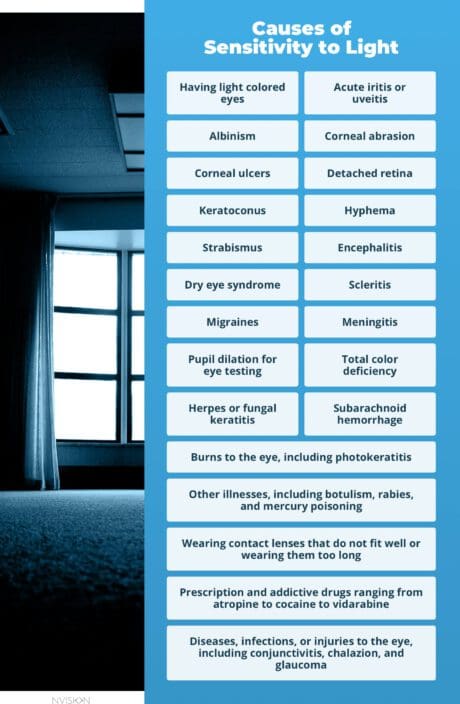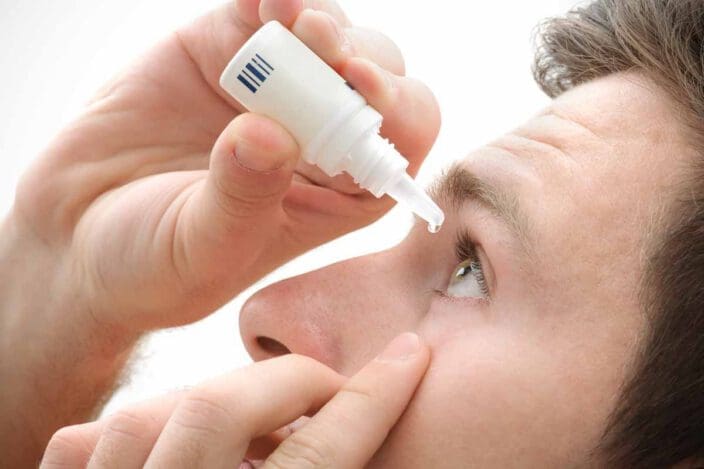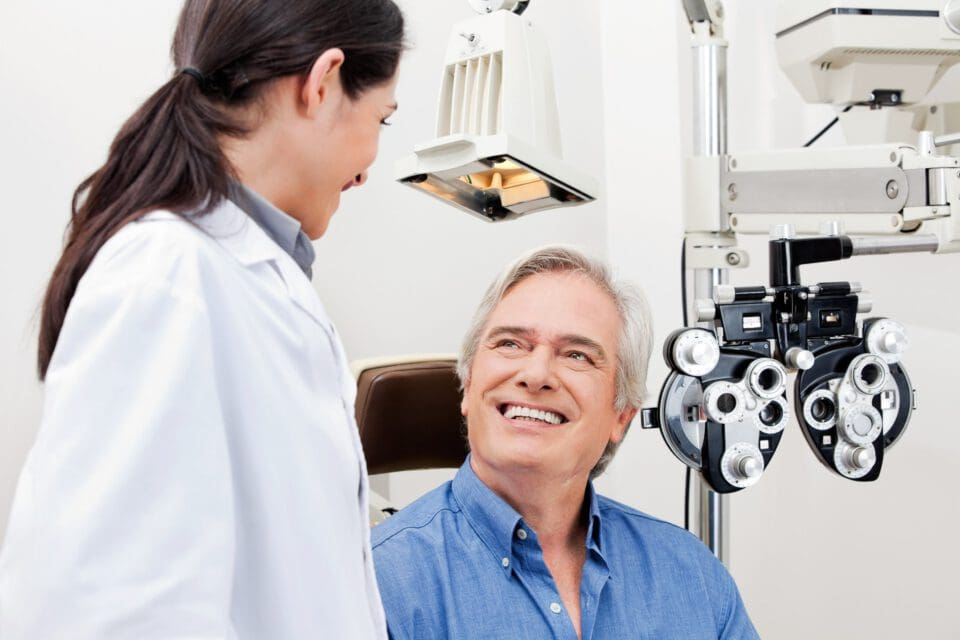Light Sensitivity: When Does It Indicate a Larger Problem?
Home / Vision Education Center /
Last Updated:
Light sensitivity is also called photophobia. It is a common experience with many underlying causes.
Table of Contents
The broad term covers many kinds of discomfort in bright light, ranging from trouble adjusting to brighter light to pain in the eyes.
People who have light-colored eyes may be more prone to light sensitivity than those with dark eyes. If you develop light sensitivity when you did not have it before, you could have an underlying problem ranging from injury or infection in the eye to a stroke or cancer.
Treating light sensitivity requires a medical diagnosis, and you may need eye drops or prescription medication to manage the condition. You can also be careful of how you interact with lights. You can wear colored glasses or UV-protecting sunglasses.
What Is Light Sensitivity?
Light sensitivity, also called photophobia, is a term that covers any sort of eye discomfort in bright light. This can range from having difficulty adjusting to brighter lights after being in a darker room to experiencing pain in the eyes or head from lights that are too bright.
While light sensitivity can be disruptive, it is a common condition, and it is often a symptom of other problems. If you develop photophobia, especially if you develop the condition rapidly, get help from your optometrist or ophthalmologist, as you may have an underlying eye disorder.
You deserve clear vision. We can help.
With 135+ locations and over 2.5 million procedures performed, our board-certified eye surgeons deliver results you can trust. Your journey to better vision starts here.
What Causes Light Sensitivity? Is It Serious?
People who have light-colored eyes are at a slightly higher risk of experiencing light sensitivity than people with darker eyes, especially dark brown eyes. This is because the melatonin in eye color can protect against some ultraviolet (UV) light and reduce how impactful bright light can be on the retina. If you have light-colored eyes, you may experience more discomfort when transitioning from a dim or indoor space to a bright or outdoor space for no specific medical reason.
There are several potential underlying eye conditions that can cause photophobia.

- Acute iritis or uveitis, which is inflammation inside the eye
- Albinism, or lack of pigment in the eye and skin
- Burns to the eye, including photokeratitis (sunburned eyes)
- Other types of keratitis, including herpes or fungal keratitis
- Corneal abrasion, or damage to the cornea
- Corneal ulcers
- Detached retina, which is a medical emergency
- Drugs, including prescription and addictive drugs ranging from atropine to cocaine to vidarabine
- Dry eye syndrome, in which the tear ducts do not make enough, or high enough quality, tears to keep the eyes moist
- Encephalitis, or swelling in the brain
- Wearing contact lenses that do not fit well or wearing them too long
- Keratoconus, or the cornea growing into a cone-like shape
- Hyphema, or blood collecting in the front of the eye
- Strabismus, or the muscles in one eye being weaker than the other and the eye turning in a different direction as a result
- Diseases, infections, or injuries to the eye, including conjunctivitis, chalazion, and glaucoma
- Other illnesses, including botulism, rabies, and mercury poisoning
- Meningitis, or damage to the spinal cord from a viral, bacterial, fungal, or other infection
- Migraines, including chronic migraines
- Total color deficiency, or being unable to see any colors
- Pupil dilation for eye testing
- Scleritis, or inflammation in the white part of the eye, typically affecting people between 30 and 50 years old, which is associated with autoimmune conditions like lupus
- Subarachnoid hemorrhage, or bleeding between the layers of tissue surrounding the brain
Diseases and damage to the eye must be immediately reported to a medical professional for treatment. Bleeding in the eye and/or brain, burns, corneal abrasions, encephalitis, and meningitis are all very harmful, and some of these conditions can be deadly.
If you have any of the following symptoms alongside light sensitivity, it may be a medical condition that needs immediate treatment:
- Pain the eye
- Dizziness
- Nausea or vomiting
- Headaches or neck aches
- Blurry vision
- Soreness in the eye unrelated to bright lights
- Wounds or spots in the eye
- Redness, itching, and swelling
- Numbness or tingling in the body
- Changes to your hearing
What is Glare?
Glare is when your visual field is exposed to a significantly greater amount of light than your eyes can comfortably handle. This most often means too much sunlight (especially while driving), but it can also come from a room in which the lights are too bright.
It can also happen at night, such as when you’re driving and the headlights of an oncoming car shine directly into your eyes.
Glare can dramatically affect your vision, sometimes to the point where you have to close your eyes. Your eyes are usually more sensitive to glare when you’re older.
There are two forms of glare: disabling and uncomfortable. People react and recover from glare in different ways depending on various factors, including exposure duration and the light intensity.
Discomfort Glare
Glare can cause discomfort or annoyance without necessarily harming your vision. Eye care specialists believe that this response to excess light is merely psychological and can be subjective.
Factors that may affect the amount of discomfort from glare include:
- Duration of exposure
- Your age and eye health
- More ambient lighting decreases discomfort from glare
- Intensity of the light
- Complexity of the visual task (you’ll experience more discomfort or distraction when looking at harder-to-see objects, such as from a distance
Disability Glare
Glare can also be disabling, temporarily reducing your visual performance. The experience can be hazardous when you are performing activities like driving.
You’re unable to see properly under this type of glare because it involves the scattering of stray light when it enters your eyes.
As people age, they’re more vulnerable to disability glare. The reasons for this include increased light scatter due to a higher amount of particles in older eyes.
Other factors that may impact vulnerability to disabling glare are:
- Ambient light
- How difficult it is to view objects/targets
- General visual health
- Duration of exposure to the glare
- The intensity of light entering the victim’s eye
You deserve clear vision. We can help.
With 135+ locations and over 2.5 million procedures performed, our board-certified eye surgeons deliver results you can trust. Your journey to better vision starts here.
How Is Light Sensitivity Treated?

To determine the cause of your light sensitivity, your eye doctor will examine your eye, including the back of your eye, to determine if there is anything in the organ itself that may be changing or damaged, which could cause the problem. They will also ask you about the frequency and severity of your light sensitivity.
Treatment approaches will depend on what is causing your photophobia, but your treatment plan may include:
- Medications to manage migraine pain or discomfort.
- Eye drops that reduce inflammation.
- Eye drops that reduce eye pressure from glaucoma.
- Antibiotics for conjunctivitis, corneal abrasions, or bacterial meningitis.
- Artificial tears for dry eyes.
- Anti-inflammatory medications, bed rest, and fluids for mild encephalitis.
- Surgery for tumors, aneurysms, or strokes.
If you have moments of light sensitivity — after going to the optometrist and having your pupils dilated, while struggling with a migraine one day, or because of an underlying condition like glaucoma — there are some steps you can take yourself to manage this experience.
- Avoid sunlight. Wear a hat and ultraviolet-protecting sunglasses, or carry a parasol when going outdoors.
- Close your eyes until the discomfort passes, and avoid looking near the sky or bright lights indoors.
- Dim the lights when you are indoors. Consider getting dimmer switches for rooms if you frequently experience light sensitivity.
- Get photochromatic glasses to reduce how certain colors in the light spectrum affect your eyes.
- Practice good hygiene, especially if you wear contact lenses, to prevent eye infections. Avoid people who may have communicable diseases like pink eye or meningitis, and get vaccines for viral conditions, like some causes of encephalitis
- Continue any treatment for underlying medical conditions, and tell your eye doctor if symptoms, including photophobia, get worse.

Protecting Yourself
Understand that light sensitivity is a symptom of a condition, especially if you were not light sensitive before and have just started to experience it. Reporting this to your optometrist or ophthalmologist can lead to diagnosis and treating a condition that may otherwise lead to vision loss.
Many people may not associate light sensitivity with an eye disease or another kind of disease. It is important to get regular eye exams to have your whole eye’s health evaluated.
You deserve clear vision. We can help.
With 135+ locations and over 2.5 million procedures performed, our board-certified eye surgeons deliver results you can trust. Your journey to better vision starts here.
References
- Photophobia. (May 10, 2017). MedlinePlus.
- Light Sensitivity. (December 8, 2015). American Academy of Ophthalmology (AAO).
- Photophobia (Light Sensitivity). (January 2018). All About Vision.
- NHTSA Workshop: Balancing Visibility and Glare. (July 13, 2004). National Highway Traffic Safety Administration. Date Fetched: July 27, 2021.
- Shedding Light on Photophobia. (March 1, 2013). Journal of Neuroophthalmology.
This content is for informational purposes only. It may have been reviewed by a licensed physician, but is not intended to serve as a substitute for professional medical advice. Always consult your healthcare provider with any health concerns. For more, read our Privacy Policy and Editorial Policy.